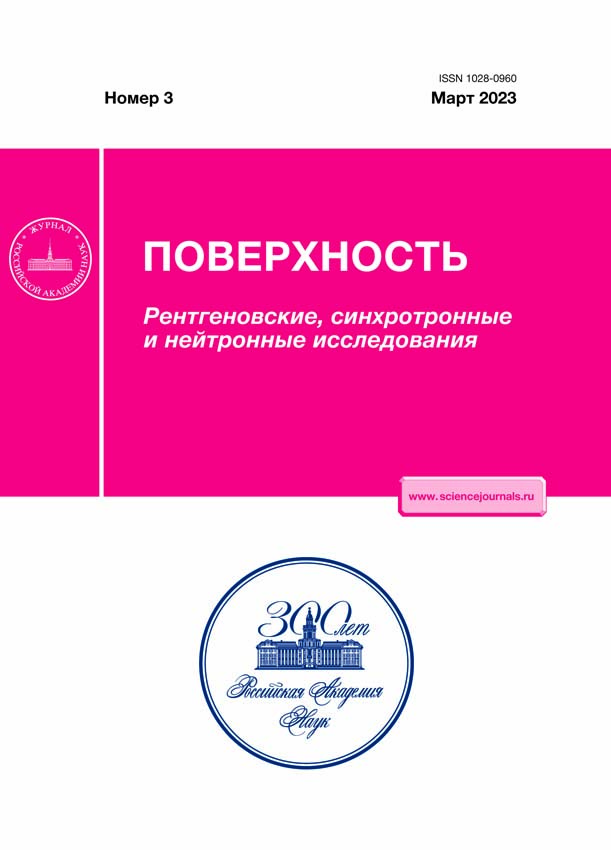Formation of Nanoclusters in Zinc-Implanted Crystalline Quartz
- Autores: Privezentsev V.V.1, Firsov A.A.1, Kulikauskas V.S.2, Zatekin V.V.2, Tereshchenko A.N.3
-
Afiliações:
- Scientific Research Institute for System Analysis RAS
- Lomonosov Moscow State University, Skobeltsyn Institute of Nuclear Physics
- Osipyan Institute of Solid State Physics RAS
- Edição: Nº 3 (2023)
- Páginas: 53-58
- Seção: Articles
- URL: https://clinpractice.ru/1028-0960/article/view/664594
- DOI: https://doi.org/10.31857/S1028096023030147
- EDN: https://elibrary.ru/LFUSDC
- ID: 664594
Citar
Texto integral
Resumo
The results of the synthesis of nanoclusters of metallic zinc and its oxide in crystalline quartz implanted with 64Zn+ ions with a dose of 5 × 1016 cm–2 and energy of 40 keV and annealed in an oxygen atmosphere in the temperature range 400–900°C are presented. Scanning electron microscopy combined with energy-dispersive spectroscopy, as well as Auger electron spectroscopy and photoluminescence, were used for the study. After implantation, separate nanoclusters of metallic zinc with a size of less than 1 µm were fixed on the surface and in the near-surface layer of quartz. It was established that, during annealing, the sample underwent a transition from the phase of metallic Zn to the phases of its oxide ZnO and silicate Zn2SiO4. After annealing at 700°C, which is the most optimal for obtaining the ZnO phase, zinc oxide nanoclusters smaller than 500 nm in size were formed in the near-surface layer of quartz. A peak in the form of a doublet at a wavelength of 370 nm was observed in the photoluminescence spectrum due to exciton luminescence in zinc oxide. After annealing at 800°C, the ZnO phase degraded and the zinc silicate phase Zn2SiO4 was formed.
Palavras-chave
Sobre autores
V. Privezentsev
Scientific Research Institute for System Analysis RAS
Autor responsável pela correspondência
Email: v.privezentsev@mail.ru
Russia, 117218, Moscow
A. Firsov
Scientific Research Institute for System Analysis RAS
Email: v.privezentsev@mail.ru
Russia, 117218, Moscow
V. Kulikauskas
Lomonosov Moscow State University, Skobeltsyn Institute of Nuclear Physics
Email: v.privezentsev@mail.ru
Russia, 119991, Moscow
V. Zatekin
Lomonosov Moscow State University, Skobeltsyn Institute of Nuclear Physics
Email: v.privezentsev@mail.ru
Russia, 119991, Moscow
A. Tereshchenko
Osipyan Institute of Solid State Physics RAS
Email: v.privezentsev@mail.ru
Russia, 142432, Moscow region, Chernogolovka
Bibliografia
- Кузьмина И.П., Никитенко В.А. Оксид цинка. Получение и свойства. M.: Нaукa, 1984. 166 с.
- Özgür Ü., Alivov Ya. I., Liu C. et al. // J. Appl. Phys. 2005. V. 98. P. 041301.
- Litton C.W, Collins T.C., Reynolds D.S, Zinc Oxide Materials for Electronic and Optoelectronic Device Application. Chichester: Wiley, 2011.
- Amekura H., Kishimoto N. Toward Functional Nanomaterials // Lecture Notes in Nanoscale Science and Technology / Ed. Wang Zh.M. 2009. V. 5.
- Liu Y.X., Liu Y.C., Shen D. et al. // J. Cryst. Growth. 2002. V. 240. P. 152.
- Zatsepin D., Zatsepin A., Boukhvalov D.W. et al. // J. Non-Cryst. Solids. 2016. V. 432. P. 183.
- Straumal B.B., Mazilkin A.A., Protasova S.G. et al. // Phys. Rev. B. 2009. V. 79. P. 205206.
- Smestad G.P., Gratzel M. // J. Chem. Educ. 1998. V. 75. P. 752.
- Urfa Y., Çorumlu V., Altındal A. // Mater. Chem. Phys. 2021. V. 264. P. 124473.
- Sirelkhatim S., Mahmud A., Seeni N.H.M., Kaus L.C., Ann S.K., ohd Bakhori, Hasan H., Mohamad D. // Nano-Micro Lett. 2015. V. 7. P. 219.
- Inbasekaran S., Senthil R., Ramamurthy G., Sastry T.P. // Intern. J. Innov. Res. Sci. Engin. Technol. 2014. V. 3. P. 8601.
- Jiang C.Y., Sun X.W., Lo G.Q. et al. // Appl. Phys. Lett. 2007. V. 90. P. 263501.
- Li C., Yang Y., Sun X.W. et al. // Nanotechnology. 2007. V. 18. P. 135604.
- Chu S., Olmedo M., Yang Zh. et al. // Appl. Phys. Lett. 2008. V. 93. P. 181106.
- Amekura H., Ohnuma M., Kishimoto N. et al. // J. Appl. Phys. 2008. V. 104. P. 114309.
- Privezentsev V.V., Makunin A.V., Batrakov A.A. et al. // Semiconds. 2018. V. 52. P. 645.
- Броудай И., Мерей Дж. Физические основы микротехнологии. М.: Мир, 1985. 496 с.
- Ziegler J.F., Biersack J.P. SRIM 2008 (http:// www.srim.org).
- Chen Y., Bagnall D.M., Koh H.J. et al. // J. Appl. Phys. 1998. V. 84. P. 3912.
- Amekura H., Umeda N., Sakuma Y. et al. // Appl. Phys. Lett. 2005. V. 87. P. 013109.
Arquivos suplementares



















